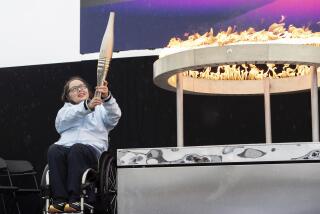London Olympics: Some events set amid historic city landmarks
LONDON — There is no way to ignore the towering cupola and arched windows, the 18th century architecture all around.
Then comes another surprise — bells tolling from Big Ben just a few blocks away.
It makes sense that beach volleyball players have felt a little out of place as they move into their new home for the 2012 London Olympics, a trio of sand courts set amid historic government and military buildings in the heart of the city.
“It’s unbelievable,” U.S. player Jake Gibb said. “I’m thinking, ‘What the you-know-what is this?’”
Volleyball at the Horse Guards Parade is but one example of a Summer Games that is trying its best to look, feel and sound exceedingly British.
Although much of the action is relegated to a sprawling, modern Olympic Park constructed on the outskirts, organizers have taken on the logistical challenge of staging a number of events in central London.
That means athletes will be sprinting, cycling, swimming and riding in the shadow of some postcard-worthy landmarks.
“That was the jigsaw we put together,” said Debbie Jevans, director of sport for the organizing committee. “We wanted to enhance the city and show off its history.”
Think panoramic shots of cyclists crossing the River Thames. Or television cameras zeroing in as runners fly past the front gates of Buckingham Palace.
No surprise that marathoners will take in a variety of sights, their course wending its way past the Tower of London, St. Paul’s Cathedral and Trafalgar Square.
The Mall, a stretch of road that connects Buckingham Palace with the Admiralty Arch, will serve as their finishing line, and the endpoint for the race walkers.
A few blocks to the west, the triathlon loops through historic Hyde Park, circling the Wellington Arch. After a test event there last summer, U.S. triathlete Jarrod Shoemaker sounded as if he had a camera dangling from his neck.
“We’re almost taking this tour of the beautiful sights of London on our bikes,” he said.
But not everyone is so thrilled.
In the months leading up to the Games, traffic has ranked among the biggest concerns in this densely populated city where residents must navigate an aging and inadequate transportation network.
“We are holding the Olympic Games in one of the busiest, most active cities in the world, and inevitably you are going to have challenges,” Prime Minister David Cameron said this week. “This is going to be an extraordinary few weeks for the city and for the country, but the people have to be prepared for that and, so far, good sense has been shown.”
Olympic organizers insist they have taken steps to keep London streets from grinding to a halt. This effort began shortly after they bid for the Games, when they met with transportation officials and various international sports federations.
“We looked at things to ensure the city does keep moving,” Jevans said.
Only sports that could fit into tight spaces were programmed for the central area, and most of the events requiring road closures will be held on weekends. Still, the city figures to be more congested than usual over the next two-plus weeks.
There will, however, be a few scenic events that won’t be in central neighborhoods.
In Greenwich, a community of quaint shops and pubs to the south, equestrian riders will compete in a park overlooking the matched domes of Sir Christopher Wren’s Old Royal Naval College.
And if sports landmarks count, then tennis has Wimbledon’s Centre Court and soccer has a roster of games at Old Trafford, home to Manchester United.
Pleasant visuals aren’t the only reason for inhabiting such locations.
Economic experts have questioned the government’s assertion that these Games — which are costing about $15 billion to stage — can provide a sizable boost to the local economy.
Organizers hope that showing Big Ben and the Houses of Parliament on television screens around the world will boost tourism in the future.
In the meantime, it is the athletes who will probably benefit most from the extraordinary surroundings.
No venue is more historic than Horse Guards Parade, a large grounds wedged between the Old Admiralty buildings and the prime minister’s residence at 10 Downing Street.
Dating back centuries, this site serves as a ceremonial facility, with red-jacketed soldiers standing guard and horsemen stationed at the front gate.
Gibb said he loves the ambience and quickly grew accustomed to hearing Big Ben toll during practice.Misty May-Treanor, a two-time Olympic gold medalist, has another reason for liking the venue.
“I, personally, would love to own a horse,” she said. “So I love the smell of horses.”
twitter.com/LATimesWharton
More to Read
Go beyond the scoreboard
Get the latest on L.A.'s teams in the daily Sports Report newsletter.
You may occasionally receive promotional content from the Los Angeles Times.







